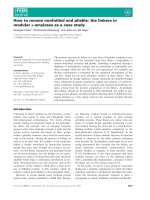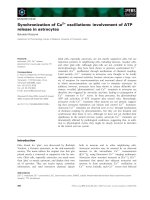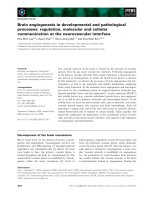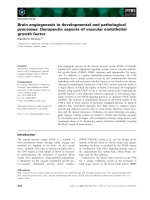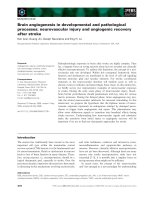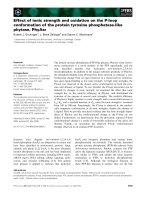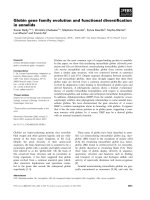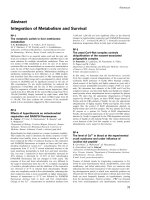Báo cáo khoa học: "Intonational Boundaries, Speech Repairs and Discourse Markers: Modeling Spoken Dialog" pdf
Bạn đang xem bản rút gọn của tài liệu. Xem và tải ngay bản đầy đủ của tài liệu tại đây (776.31 KB, 8 trang )
Intonational Boundaries, Speech Repairs and
Discourse Markers: Modeling Spoken Dialog
Peter A. Heeman and James F. Allen
Department of Computer Science
University 9f Rochester
Rochester NY 14627, USA
{heeman, j ames }~cs. rochester,
edu
Abstract
To understand a speaker's turn of a con-
versation, one needs to segment it into in-
tonational phrases, clean up any speech re-
pairs that might have occurred, and iden-
tify discourse markers. In this paper, we
argue that these problems must be resolved
together, and that they must be resolved
early in the processing stream. We put for-
ward a statistical language model that re-
solves these problems, does POS tagging,
and can be used as the language model of
a speech recognizer. We find that by ac-
counting for the interactions between these
tasks that the performance on each task
improves, as does POS tagging and per-
plexity.
1
Introduction
Interactive spoken dialog provides many new chal-
lenges for natural language understanding systems.
One of the most critical challenges is simply de-
termining the speaker's intended utterances: both
segmenting the speaker's turn into utterances and
determining the intended words in each utterance.
Since there is no well-agreed to definition of what
an utterance is, we instead focus on intonational
phrases (Silverman et al., 1992), which end with an
acoustically signaled
boundary lone.
Even assuming
perfect word recognition, the problem of determin-
ing the intended words is complicated due to the
occurrence of speech repairs, which occur where the
speaker goes back and changes (or repeats) some-
thing she just said. The words that are replaced
or repeated are no longer part of the intended ut-
terance, and so need to be identified. The follow-
ing example, from the Trains corpus (Heeman and
Allen, 1995), gives an example of a speech repair
with the words that the speaker intends to be re-
placed marked by
reparandum,
the words that are
the intended replacement marked as
alteration,
and
the cue phrases and filled pauses that tend to occur
in between marked as the
editing term.
Example 1 (d92a-5.2 utt34)
we'll pick up ~. uh the tanker of
oranges
reparandu "q'ml ~ • ~ •
editing term
alteration
interruption point
Much work has been done on both detect-
ing boundary tones (e.g. (Wang and Hirschberg,
1992; Wightman and Ostendorf, 1994; Stolcke and
Shriberg, 1996a; Kompe et al., 1994; Mast et al.,
1996)) and on speech repair detection and correction
(e.g. (Hindle, 1983; Bear, Dowding, and Shriberg,
1992; Nakatani and Hirschberg, 1994; Heeman and
Allen, 1994; Stolcke and Shriberg, 1996b)). This
work has focused on one of the issues in isolation of
the other. However, these two issues are intertwined.
Cues such as the presence of silence, final syllable
lengthening, and presence of filled pauses tend to
mark both events. Even the presence of word cor-
respondences, a tradition cue for detecting and cor-
recting speech repairs, sometimes marks boundary
tones as well, as illustrated by the following example
where the intonational phrase boundary is marked
with the ToBI symbol %.
Example 2 (d93-83.3 utt73)
that's all
you need
% you only
need one
boxcar
Intonational phrases and speech repairs also in-
teract with the identification of discourse markers.
Discourse markers (Schiffrin, 1987; Hirschberg and
Litman, 1993; Byron and Heeman, 1997) are used
to relate new speech to the current discourse state.
Lexical items that can function as discourse mark-
ers, such as "well" and "okay," are ambiguous as to
whether they are being used as discourse markers
or not. The complication is that discourse markers
tend to be used to introduce a new utterance, or
can be an utterance all to themselves (such as the
acknowledgment "okay" or "alright"), or can be used
as part of the editing term of a speech repair, or to
begin the alteration. Hence, the problem of identi-
fying discourse markers also needs to be addressed
with the segmentation and speech repair problems.
These three phenomena of spoken dialog, however,
cannot be resolved without recourse to syntactic in-
formation. Speech repairs, for example, are often
254
signaled by syntactic anomalies. Furthermore, in
order to determine the extent of the reparanduin,
one needs to take into account the parallel structure
that typically exists between the reparandum and al-
teration, which relies on at identifying the s:?ntactic
roles, or part-of-speech (POS) tags, of the words in-
volved (Bear, Dowding, and Shriberg, 1992; Heeman
and Allen, 1994). However, speech repairs disrupt
the context that is needed to determine the POS
tags (Hindle, 1983). Hence, speech repairs, as well
as boundary tones and discourse markers, must be
resolved during syntactic disambiguation.
Of course when dealing with spoken dialogue, one
cannot forget the initial problem of determining the
actual words that the speaker is saying. Speech rec-
ognizers rely on being able to predict the probabil-
ity of what word will be said next. Just as intona-
tional phrases and speech repairs disrupt the local
context that is needed for syntactic disambiguation,
the same holds for predicting what word will come
next. If a speech repair or intonational phrase oc-
curs, this will alter the probability estimate. But
more importantly, speech repairs and intonational
phrases have acoustic correlates such as the pres-
ence of silence. Current speech recognition language
models camlot account for the presence of silence,
and tend to simply ignore it. By modeling speech re-
pairs and intonational boundaries, we can take into
account the acoustic correlates and hence use more
of the available information.
From the above discussion, it is clear that we need
to model these dialogue phenomena together and
very early on in the speech processing stream, in
fact, during speech recognition. Currently, the ap-
proaches that work best in speech recognition are
statistical approaches that are able to assign proba-
bility estimates for what word will occur next given
the previous words. Hence, in this paper, we in-
troduce a statistical language model that can de-
tect speech repairs, boundary tones, and discourse
markers, and can assign POS tags, and can use this
information to better predict what word will occur
next.
In the rest of the paper, we first introduce the
Trains corpus. We then introduce a statistical lan-
guage model that incorporates POS tagging and the
identification of discourse markers. We then aug-
meat this model with speech repair detection and
correction and intonational boundary tone detec-
tion. We then present the results of this model on
the Trains corpus and show that it can better ac-
count for these discourse events than can be achieved
by modeling them individually. We also show that
by modeling these two phenomena that we can in-
crease our POS tagging performance by 8.6%, and
improve our ability to predict the next word.
Dialogs 98
Speakers 34
Words 58298
Turns 6163
Discourse Markers 8278
Boundary Tones 10947
Turn-Internal Boundary Tones 5535
Abridged Repairs 423
Modification Repairs 1302
Fresh Starts 671
Editing Terms 1128
Table 1: Frequency of Tones, Repairs and Editing
Terms in the Trains Corpus
2 Trains Corpus
As part of the TRAINS project (Allen et al., 1995),
which is a long term research project to build a con-
versationally proficient planning assistant, we have
collected a corpus of problem solving dialogs (Hee-
man and Allen, 1995). The dialogs involve two hu-
man participants, one who is playing the role of a
user and has a certain task to accomplish, and an-
other who is playing the role of the system by acting
as a planning assistant. The collection methodology
was designed to make the setting as close to human-
computer interaction as possible, but was not a
wiz-
ard
scenario, where one person pretends to be a com-
puter. Rathor, the user knows that he is talking to
another person.
The TaAINS corpus consists of about six and half
hours of speech. Table 1 gives some general statistics
about the corpus, including the number of dialogs,
speakers, words, speaker turns, and occurrences of
discourse markers, boundary tones and speech re-
pairs.
The speech repairs in the Trains corpus have been
hand-annotated. We have divided the repairs into
three types:
fresh starts, modification repairs,
and
abridged repairs. 1
A fresh start is where the speaker
abandons the current utterance and starts again,
where the abandonment seems acoustically signaled.
Example 3 (d93-12.1 utt30)
so it'll take um so you want to do what
reparandum| editing term alteration
interruption point
The second type of repairs are the modification re-
pairs. These include all other repairs in which the
reparandum is not empty.
Example 4 (d92a-l.3 utt65)
so that will total will take seven hours to do that
reparandumT
alteration
interruption point
1This classification is similar to that of Hindle (1983)
and Levelt (1983).
255
The third type of repairs are the abridged repairs,
which consist solely of an editing term. Note that
utterance initial filled pauses are not treated as
abridged repairs.
Example 5 (d93-14.3 utt42)
we need to um manage to get the bananas to Dansville
T editing term
interruption point
There is typically a correspondence between
the reparandum and the alteration, and following
Bear
et al.
(1992), we annotate this using the la-
bels m for word matching and r for word replace-
ments (words of the same syntactic category). Each
pair is given a unique index. Other words in the
reparandum and alteration are annotated with an
x. Also, editing terms (filled pauses and clue words)
are labeled with et, and the interruption point with
ip, which will occur before any editing terms asso-
ciated with the repair, and after a word fragment,
if present. The interruption point is also marked as
to whether the repair is a fresh start, modification
repair, or abridged repair, in which cases, we use
ip:ean, ip:mod and ip:abr, respectively. The ex-
ample below illustrates how a repair is annotated in
this scheme.
Example 6 (d93-15.2 utt42)
engine two from Elmi(ra)- or engine three from Elmira
ml r2 m3 m4
Tet
ml r2 m3 m4
ip:mod
3 A POS-Based Language Model
The goal of a speech recognizer is to find the se-
quence of words l~ that is maximal given the acous-
tic signal A. However, for detecting and correcting
speech repairs, and identifying boundary tones and
discourse markers, we need to augment the model
so that it incorporates shallow statistical analysis, in
the form of POS tagging. The POS tagset, based on
the Penn Treebank tagset (Marcus, Santorini, and
Marcinkiewicz, 1993), includes special tags for de-
noting when a word is being used as a discourse
marker. In this section, we give an overview of our
basic language model that incorporates POS tag-
ging. Full details can be found in (Heeman and
Allen, 1997; Heeman~ 1997).
To add in POS tagging, we change the goal of the
speech recognition process to find the best word and
POS tags given the acoustic signal. The derivation
of the acoustic model and language model is now as
follows.
IfVP = argmaxPr(WPIA)
W,P
Pr(A[WP)
Pr(WP)
:- arg max
WP
Pr(A)
= argmaxPr(AIWP
)
Pr(WP)
WY
The first term
Pr(AIWP )
is the factor due to
the acoustic model, which we can approximate by
Pr(A[W). The second term Pr(WP) is the factor
due to the language model. We rewrite Pr(WP) as
Pr(WI,NPI,N),
where N is the number of words in
the sequence. We now rewrite the language model
probability as follows.
Pr( W1,N P1,N )
= H Pr(WiPilWl,i-lPl, i-1)
i=l,N
= 1-I Pr(WiIWl,i-lPl, i) Pr(PilW~i-lPl'i-1)
i=l,N
We now have two probability distributions that we
need to estimate, which we do using decision trees
(Breiman et al., 1984; Bahl et al., 1989). The de-
cision tree algorithm has the advantage that it uses
information theoretic measures to construct equiva-
lence classes of the context in order to cope with
sparseness of data. The decision tree algorithm
starts with all of the training data in a single leaf
node. For each leaf node, it looks for the question
to ask of the context such that splitting the node
into two leaf nodes results in the biggest decrease
in
impurity,
where tile impurity measures how well
each leaf predicts the events in the node. After the
tree is grown, a heldout dataset is used to smooth
the probabilities of each node with its parent (Bahl
et al., 1989).
To allow the decision tree to ask about the words
and POS tags in the context, we cluster the words
and POS tags using the algorithm of Brown
et
al.
(1992) into a binary classification tree. This gives
an implicit binary encoding for each word and POS
tag, thus allowing the decision tree to ask about the
words and POS tags using simple binary questions,
such as 'is the third bit of the POS tag encoding
equal to one?' Figure 1 shows a POS classification
tree. The binary encoding for a POS tag is deter-
mined by the sequence of top and bottom edges that
leads from the root node to the node for the POS
tag.
Unlike other work (e.g. (Black et al., 1992; Mater-
man, 1995)), we treat the word identities as a further
refinement of the POS tags; thus we build a word
classification tree for each POS tag. This has the
advantage of avoiding unnecessary data fragmenta-
tion, since the POS tags and word identities are no
longer separate sources of information. As well, it
constrains the task of building the word classifica-
tion trees since the major distinctions are captured
by the POS classification tree.
4 Augmenting the Model
Just as we redefined the speech recognition prob-
lem so as to account for POS tagging and identify-
ing discourse markers, we do the same for modeling
256
Figure 1: POS Classification Tree
boundary tones and speech repairs. We introduce
null tokens between each pair of consecutive words
wi-1
and
wi
(Heeman and Allen, 1994), which wilt
be tagged as to the occurrence of these events. The
boundary tone tag T/ indicates if word
wi-1
ends an
intonational boundary (T~=T), or not (T~=null).
For detecting speech repairs, we have the prob-
lem that repairs are often accompanied by an edit-
ing term, such as "um", "uh", "okay", or "well",
and these must be identified as such. Furthermore,
an editing term might be composed of a number of
words, such as "let's see" or
"uh
well". Hence we use
two tags: an editing term tag
Ei
and a repair tag
Ri.
The editing term tag indicates if
wi
starts an edit-
ing term
(Ei=Push),
if
wi
continues an editing term
(Ei=ET), if
wi-~
ends an editing term (Ei=Pop),
or otherwise
(Ei=null).
The repair tag
Ri
indicates
whether word
wi
is the onset of the alteration of a
fresh start (Ri=C), a modification repair (Ri=M),
or an abridged repair (Ri=A), or there is not a re-
pair
(Ri=null).
Note that for repairs with an edit-
ing term, the repair is tagged after the extent of the
editing term has been determined. Below we give an
example showing all non-null tone, editing term and
repair tags.
Example 7 (d93-18.1 utt47)
it takes one Push you ET know Pop M two hours T
If a modification repair or fresh start occurs,
we need to determine the extent (or the onset)
of the reparandum, which we refer to as
correct-
ing
the speech repair. Often, speech repairs have
strong word correspondences between the reparan-
we'll pick up a tank of uh the tanker of oranges
' I 'tl
Figure 2: Cross Serial Correspondences
dum and alteration, involving word matches and
word replacements. Hence, knowing the extent of
the reparandum means that we can use the reparan-
dum to predict the words (and their POS tags) that
make up the alteration. For
Ri E
{Mod, Can}, we
define Oi to indicate the onset of the reparandum. 2
If we are in the midst of processing a repair, we
need to determine if there is a word correspondence
from the reparandum to the current word
wi.
The
tag
Li
is used to indicate which word in the reparan-
dum is licensing the correspondence. Word cor-
respondences tend to exhibit a cross serial depen-
dency; in other words if we have a correspondence
between
wj
in the reparandum and wk in the alter-
ation, any correspondence with a word in the alter-
ation after w~ will be to a word that is after wj, as il-
lustrated in Figure 2. This means that if
wi
involves
a word correspondence, it will most likely be with a
word that follows the last word in the reparandum
that has a word correspondence. Hence, we restrict
LI to only those words that are after the last word in
the reparandum that has a correspondence (or from
the reparandum onset if there is not yet a correspon-
dence). If there is no word correspondence for
wi,
we
set
Li
to the first word after the last correspondence.
The second tag involved in the correspondences is
Ci,
which indicates the type of correspondence be-
tween the word indicated by
Li
and the current word
wi.
We focus on word correspondences that involve
either a word match (Ci=m), a word replacement
(Ci=r),
where both words are of the same POS tag,
or no correspondence (Ci=x).
Now that we have defined these six additional tags
for modeling boundary tones and speech repairs, we
redefine the speech recognition problem so that its
goal is to find the maximal assignment for the words
as well as the POS, boundary tone, and speech repair
tags.
WPCLORET
= arg max
Pr(WCLORET[A)
WPCLOItET
The result is that we now have eight probability dis-
tributions that we need to estimate.
Pr (Ti I Wl,i- 1Pl,i-1Cl,i-1Ll,
i-101,1-1Rl,i-i El,i-1Tl,i-1 )
Pr( EilWl,i- 1Pl,i-1CI,i-1Ll,l-1
01,1-1Rl,i- 1
El,l-1Tl,i)
Pr(Ri [WI,i-1Pl, i-1
el,i- 1 .LI,I- 10l~i-1
RI,I-1
El,iTl,i )
Pr (Oi [ Wl,i-1Pl,i-1Cl,i-1Ll,i-101,1-1Rl,iEl,iTl,i)
Pr(Li
[W1,,-1Pl,i-1Cl, i-1Ll, i-101,1Rl,i EI,,TI,i )
2Rather than estimate
Oi
directly, we instead query
each potential onset to see how likely it is to be the actual
onset of the reparandum.
257
Pr(CiIW~,+-~
PJ,+-~ Ct,+-~ Ll,i Ol,i Rl,i El, i Zl,i )
Pr( Pi l Wl,i-1PI, i-1CI,i L I,i 01,i R I,i El,i Tl,i )
Pr(W,
Pl,i Cl,i L l,i
Ol,i Rl,i
El,i Zl,i
)
The context for each of the probability distribu-
tions includes all of the previous context. In princi-
pal, we could give all of this context to the decision
tree algorithm and let it decide what information
is relevant in constructing equivalence classes of the
contexts. However, the amount of training data is
limited (as are the learning techniques) and so we
need to encode the context in order to simplify the
task of constructing meaningflfl equivalence classes.
We start with the words and their POS tags that
are in the context and for each non-null tone, editing
term (we also skip over E=ET), and repair tag, we
insert it into the appropriate place, just as Kompe
et
al.
(1994) do for boundary tones in their language
model. Below we give the encoded context for the
word "know" from Example 7
Example 8 (d93-18.1 utt47)
it/PRP takes/VBP one/CD Push you/PRP
The result of this is that the non-null tag values are
treated just as if they were lexical items. 3 Further-
more, if an editing term is completed, or the extent
of a repair is known, we can also clean up the edit-
ing term or reparandum, respectively, in the same
way that Stolcke and Shriberg (1996b) clean up filled
pauses, and simple repair patterns. This means that
we can then generalize between fluent speech and
instances that have a repair. For instance, in the
two examples below, the context for the word "get"
and its POS tag will be the same for both, namely
"so/CC_D we/PRP need/VBP to/TO".
Example 9 (d93-11.1 utt46)
so we need to get the three tankers
Example 10 (d92a-2.2 utt6)
so we need to Push um Pop A get a tanker of OJ
We also include other features of the context. For
instance, we include a variable to indicate if we are
currently processing an editing term, and whether
a non-filled pause editing term was seen. For es-
timating
Ri,
we include the editing terms as well.
For estimating
Oi,
we include whether the proposed
reparandum includes discourse markers, filled pauses
that are not part of an editing term, boundary terms,
and whether the proposed reparandum overlaps with
any previous repair.
5 Silences
Silence, as well as other acoustic information, can
also give evidence as to whether an intonational
phrase, speech repair, or editing term occurred. We
3Since we treat the non-null tags as lexical items, we
associate a unique POS tag with each value.
, , , , , ,
Fluant
Tone
Modification
Fresh
Starl
Push
.
, Pop
/
'\ ,._ , ,,,, ".+,,,
: .#'% :, <+ <
t'" /- '.,
it}',." "' " "
'~ ::~ .
L_, " : _
0.5 1 1.5 2 2.5 3 3.5
Figure 3: Preference for tone, editing term, and re-
pair tags given the length of silence
include
Si,
the silence duration between word
wi-1
and
wi,
as part of the context for conditioning the
probability distributions for the tone T/, editing
term
El,
and repair
Ri
tags. Due to sparseness of
data, we make several the independence assumptions
so that we can separate the silence information from
the rest of the context. For example, for the tone
tag, let
Resti
represent the rest of the context that
is used to condition T/. By assuming that
Resti
and
Si
are independent, and are independent given T/,
we can rewrite
Pr(TiISiResti)
as follows.
. Pr(2qlSi-1)
Pr(T~lS~Rest~)
= Pr(filResh)
Pr(T, IS, )
We can now use P,-(T,) as a factor to modify the
tone probability in order to take into account the
silence duration. In Figure 3, we give the factors
by which we adjust the tag probabilities given the
amount of silence. Again, due to sparse of data,
we collapse the values of the tone, editing term and
repair tag into six classes: boundary tones, editing
term pushes, editing term pops, modification repairs
and fresh starts (without an editing term). From
the figure, we see that if there is no silence between
wi-1 and
wi,
the null interpretation for the tone,
repair and editing term tags is preferred. Since the
independence assumptions that we have to make are
too strong, we normalize the adjusted tone, editing
term and repair tag probabilities to ensure that they
sum to one over all of the values of the tags.
6 Example
To demonstrate how the model works, consider the
following example.
Example 11 (d92a-2.1 utt95)
will take a total of um let's see total of s- of 7 hours
reparandum | et reparandum l
iV iV
The language model considers all possible interpre-
tations (at least those that do not get pruned) and
assigns a probability to each. Below, we give the
probabilities for the correct interpretation of the
258
word "um", given.the correct interpretation of the
words "will take a total of". For reference, we give
a simplified view of the context that is used for each
probability.
Pr(T6=null[a total of)=0.98
Pr(E6=Pushla total of)=0.28
Pr(R~=nultla total of Push)=l.00
Pr(P6=UH_FP[a total of Push)=0.75
Pr(Ws=um[a total of Push UH_FP)=0.33
Given the correct interpretation of the previous
words, the probability of the filled pause "urn" along
with the correct POS tag, boundary tone tag, and
repair tags is 0.0665.
Now lets consider predicting the second instance
of "total", which is the first word of the alteration of
the first repair, whose editing term "urn let's see",
which ends with a boundary tone, has just finished.
Pr(T10=TlPush let's see)=0.93
Pr(E:0=PoPlPush let's see Tone)=0.79
Pr(R10=Mla total of Push let's see Pop) = 0.26
Pr(O10=totallwill take a total of R10=Mod)=0.07
Pr(L10=totalltotal of R10=Mod)=0.94
Pr(C10=mlwill take a L10=total/NN) = 0.87 4
Pr(P10=NN]will take a L10=total/NN C10=m)=l
Pr(W10=total[will take a NN L10=totai C10 m)=l
Given the correct interpretation of the previous
words, the probability of the word "total" along with
the correct POS tag, boundary tone tag, and repair
tags is 0.011.
7 Results
To demonstrate our model, we use a 6-fold cross
validation procedure, in which we use each sixth of
the corpus for testing data, and the rest for train-
ing data. We start with the word transcriptions of
the Trains corpus, thus allowing us to get a clearer
indication of the performance of our model without
having to take into account the poor performance
of speech recognizers on spontaneous speech. All si-
lence durations are automatically obtained from a
word aligner (Ent, 1994).
Table 2 shows how POS tagging, discourse marker
identification and perplexity benefit by modeling the
speaker's utterance. The POS tagging results are re-
ported as the percentage of words that were assigned
the wrong tag. The detection of discourse markers is
reported using recall and precision. The recall rate
of X is the number of X events that were correctly
determined by the algorithm over the number of oc-
currences of X. The precision rate is the number
of X events that were correctly determined over the
number of times that the algorithm guessed X. The
error rate is the number of X events that the algo-
rithm missed plus the number of X events that it
incorrectly guessed as occurring over the number of
X events. The last measure is perplexity, which is
Base
Model
Tones
Tones Repairs
Repairs Corrections
Corrections Silences
POS Tagging
Error Rate 2.95 2.86 2.69
Discourse Markers
Recall 96.60 96.60 97.14
Precision 95.76 95.86 96.31
Error Rate 7.67 7.56 6.57
Perplexity 24.35 23.05 22.45
Table 2: POS Tagging and Perplexity Results
Tones
Repairs
Tones Corrections
Tones Silences Silences
Within Turn
Recall 64.9 70.2 70.5
Precision 67.4 68.7 69.4
Error Rate 66.5 61.9 60.5
All Tones
Recall 80.9 83.5 83.9
Precision 81.0 81.3 81.8
Error Rate 38.0 35.7 34.8
Perplexity 24.12 23.78 22.45
Table 3: Detecting Intonational Phrases
a way of measuring how well the language model is
able to predict the next word. The perplexity of a
test set of N words Wl,g is calculated as follows.
1 N
2-~ ~,=1
l°g2
Pr(wdwl, ~-')
The second column of Table 2 gives the results
of the POS-based model, the third column gives
the results of incorporating the detection and cor-
rection of speech repairs and detection of intona-
tional phrase boundary tones, and the fourth col-
umn gives the results of adding in silence informa-
tion. As can be seen, modeling the user's utterances
improves POS tagging, identification of discourse
markers, and word perplexity; with the POS er-
ror rate decreasing by 3.1% and perplexity by 5.3%.
Furthermore, adding in silence information to help
detect the boundary tones and speech repairs results
in a further improvement, with the overall POS tag-
ging error rate decreasing by 8.6% and reducing per-
plexity by 7.8%. In contrast, a word-based trigram
backoff model (Katz, 1987) built with the CMU sta-
tistical language modeling toolkit (Rosenfeld, 1995)
achieved a perplexity of 26.13. Thus our full lan-
guage model results in 14.1% reduction in perplex-
ity.
Table 3 gives the results of detecting intonational
boundaries. The second column gives the results
of adding the boundary tone detection to the POS
model, the third column adds silence information,
259
Repairs
Repairs Corrections
Repairs Silences Silences
Detection
Recall 67.9 72.7
Precision 80.6 77.9
Error Rate 48.5 47.9
Correction
Recall
Precision
Error Rate
Perplexity 24.11 23.72
Tones
Repairs
Corrections
Silences
75.7 77.0
80.8 84.8
42.4 36.8
62.4 65.0
66.6 71.5
68.9 60.9
23.04 22.45
Table 4: Detecting and Correcting Speech Repairs
and the fourth column adds speech repair detection
and correction. We see that adding in silence infor-
mation gives a noticeable improvement in detecting
boundary tones. Furthermore, adding in the speech
repair detection and correction further improves the
results of identifying boundary tones. Hence to de-
tect intonational phrase boundaries in spontaneous
speech, one should also model speech repairs.
Table-4 gives the results of detecting and correct-
ing speech repairs. The detection results report the
number of repairs that were detected, regardless of
whether the type of repair (e.g. modification repair
versus abridged repair) was properly determined.
The second column gives the results of adding speech
repair detection to the POS model. The third col-
umn adds in silence information. Unlike the case for
boundary tones, adding silence does not have much
of an effect. 4 The fourth column adds in speech re-
pair correction, and shows that taking into account
the correction, gives better detection rates (Heeman,
Loken-Kim, and Allen, 1996). The fifth column adds
in boundary tone detection, which improves both the
detection and correction of speech repairs.
8 Comparison to Other Work
Comparing the performance of this model to oth-
ers that have been proposed in the literature is very
difficult, due to differences in corpora, and different
input assumptions. However, it is useful to compare
the different techniques that are used.
Bear
et al.
(1992) used a simple pattern matching
approach on ATIS word transcriptions. They ex-
clude all turns that have a repair that just consists
of a filled pause or word fragment. On this subset
they obtained a correction recall rate of 43% and a
precision of 50%.
Nakatani and Hirschberg (1994) examined how
speech repairs can be detected using a variety of
information, including acoustic, presence of word
4Silence has a bigger effect on detection and correc-
tion if boundary tones are modeled.
matchings, and POS tags. Using these clues they
were able to train a decision tree which achieved a
recall rate of 86.1% and a precision of 92.1% on a set
of turns in which each turn contained at least one
speech repair.
Stolcke and Shriberg (1996b) examined whether
perplexity can be improved by modeling simple
types of speech repairs in a language model. They
find that doing so actually makes perplexity worse,
and they attribute this to not having a linguistic seg-
mentation available, which would help in modeling
filled pauses. We feel that speech repair modeling
must be combined with detecting utterance bound-
aries and discourse markers, and should take advan-
tage of acoustic information.
For detecting boundary tones, the model of
Wightman and Ostendorf (1994) achieves a recall
rate of 78.1% and a precision of 76.8%. Their better
performance is partly attributed to richer (speaker
dependent) acoustic modeling, including phoneme
duration, energy, and pitch. However, their model
was trained and tested on professionally read speech,
rather than spontaneous speech.
Wang and Hirschberg (1992) did employ sponta-
neous speech, namely, the ATIS corpus. For turn-
internal boundary tones, they achieved a recall rate
of 38.5% and a precision of 72.9% using a decision
tree approach that combined both textual features,
such as POS tags, and syntactic constituents with
intonational features. One explanation for the differ-
ence in performance was that our model was trained
on approximately ten times as much data. Secondly,
their decision trees are used to classify each data
point independently of the next, whereas we find
the best interpretation over the entire turn, and in-
corporate speech repairs.
The models of Kompe
et al.
(1994) and Mast et
al.
(1996) are the most similar to our model in
terms of incorporating a language model. Mast
et
al.
achieve a recall rate of 85.0% and a precision of
53.1% on identifying dialog acts in a German cor-
pus. Their model employs richer acoustic modeling,
however, it does not account for other aspects of ut-
terance modeling, such as speech repairs.
9 Conclusion
In this paper, we have shown that the problems
of identifying intonational boundaries and discourse
markers, and resolving speech repairs can be tack-
led by a statistical language model, which uses lo-
cal context. We have also shown that these tasks,
along with POS tagging, should be resolved to-
gether. Since our model can give a probability esti-
mate for the next word, it can be used as the lan-
guage model for a speech recognizer. In terms of
perplexity, our model gives a 14% improvement over
word-based language models. Part of this improve-
ment is due to being able to exploit silence durations,
260
which traditional word-based language models tend
to ignore. Our next step is to incorporate this model
into a speech recognizer in order to validate that the
improved perplexity does in fact lead to a better
word recognition rate.
10 Acknowledgments
This material is based upon work supported by the
NSF under grant IRI-9623665 and by ONR under
grant N00014-95-1-1088. Final preparation of this
paper was done while the first author was visiting
CNET, France T~l~com.
References
Allen, J. F., L. Schubert, G. Ferguson, P. Heeman,
C. Hwang, T. Kato, M. Light, N. Martin, B. Miller,
M. Poesio, and D. Traum. 1995. The Trains project:
A case study in building a conversational planning
agent.
Journal of Experimental and Theoretical AI,
7:7-48.
Bahl, L. R., P. F. Brown, P. V. deSouza, and R. L. Mer-
cer. 1989. A tree-based statistical language model
for natural lnaguage speech recognition.
IEEE Trans-
actions on Acoustics, Speech, and Signal Processing,
36(7):1001-1008.
Bear, J., J. Dowding, and E. Shriberg. 1992. Integrating
multiple knowledge sources for detection and correc-
tion of repairs in human-computer dialog. In
Proceed-
ings of the
30 th
Annual Meeting of the Association for
Computational Linguistics,
pages 56-63.
Black, E., F. Jelinek, J. Lafferty, R. Mercer, and
S. Roukos. 1992. Decision tree models applied to the
labeling of text with parts-of-speech. In
Proceedings of
the DARPA Speech and Natural Language Workshop,
pages 117-121. Morgan Kaufmann.
Breiman, L., J. H. Friedman, R. A. Olshen, and C. J.
Stone. 1984.
Classification and Regression Trees.
Monterrey, CA: Wadsworth & Brooks.
Brown, P. F., V. J. Della Pietra, P. V. deSouza, J. C.
Lai, and R. L. Mercer. 1992. Class-based n-gram
models of natural language.
Computational Linguis-
tics,
18(4):467-479.
Byron, D. K. and P. A. Heeman. 1997. Discourse marker
use in task-oriented spoken dialog. In
Proceedings of
the
5 th
European Conference on Speech Communica-
tion and Technology (Eurospeech),
Rhodes, Greece.
Entropic Research Laboratory, Inc., 1994.
Aligner Ref-
erence Manual.
Version 1.3.
Heeman, P. and J. Allen. 1994. Detecting and correct-
ing speech repairs. In
Proceedings of the
32 th
Annual
Meeting of the Association for Computational Linguis-
tics,
pages 295-302, Las Cruces, New Mexico, June.
Heeman, P. A. 1997. Speech repairs, intonational
boundaries and discourse markers: Modeling speakers'
utterances in spoken dialog. Doctoral dissertation.
Heeman, P. A. and J. F. Allen. 1995. The Trains spo-
ken dialog corpus. CD-ROM, Linguistics Data Con-
sortium.
Heeman, P. A. and J. F. Allen. 1997. Incorporating POS
tagging into language modeling. In
Proceedings of the
5 th European Conference on Speech Communication
and Technology (Eurospeech),
Rhodes, Greece.
Heeman, P. A., K. Loken-Kim, and J. F. Allen. 1996.
Combining the detection and correction of speech re-
pairs. In
Proceedings of the 4rd International Con-
ference on Spoken Language Processing (ICSLP-96),
pages 358-361, Philadephia, October.
ttindle, D. 1983. Deterministic parsing of syntactic non-
fluencies. In
Proceedings of the 21 st Annual Meeting of
the Association for Computational Linguistics,
pages
123-128.
Hirschberg, J. and D. Litman. 1993. Empirical studies
on the disambiguation of cue phrases.
Computational
Linguistics,
19(3):501-530.
Katz, S. M. 1987. Estimation of probabilities from
sparse data for the language model component of a
speech recognizer.
IEEE Transactions on Acoustics,
Speech, and Signal Processing,
pages 400-401, March.
Kompe, R., A. Battiner, A. Kiefling, U. Kilian, H. Nie-
mann, E. NSth, and P. Regel-Brietzmann. 1994. Au-
tomatic classification of prosodically marked phrase
boundaries in german. In
Proceedings of the Interna-
tional Conference on Audio, Speech and Signal Pro-
cessing (ICASSP),
pages 173-176, Adelaide.
Levelt, W. J. M. 1983. Monitoring and self-repair in
speech.
Cognition,
14:41-104.
Magerman, D. M. 1995. Statistical decision trees fol
parsing. In
Proceedings of the
33 th
Annual Meeting of
the Association for Computational Linguistics,
pages
7-14, Cambridge, MA, June.
Marcus, M. P., B. Santorini, and M. A. Marcinkiewicz.
1993. Building a large annotated corpus of en-
glish: The Penn Treebank.
Computational Linguis-
tics,
19(2):313-330.
Mast, M., R. Kompe, S. Harbeck, A. Kieflling, H. Nie-
mann, E. NSth, E. G. Schukat-Taiamazzini, and
V. Warnke. 1996. Dialog act classification with the
help of prosody. In
Proceedings of the 4rd Inter-
national Conference on Spoken Language Processing
(ICSLP-96),
Philadephia, October.
Nakatani, C. H. and J. Hirschberg. 1994. A
corpus-based study of repair cues in spontaneous
speech.
Journal of the Acoustical Society of America,
95(3):1603-1616.
Rosenfeld, R. 1995. The CMU statistical language mod-
eling toolkit and its use in the 1994 ARPA CSR evai-
uation. In
Proceedings of the ARPA Spoken Language
Systems Technology Workshop,
San Mateo, California,
1995. Morgan Kaufmann.
Schiffrin, D. 1987.
Discourse Markers.
New York: Cam-
bridge University Press.
Silverman, K., M. Beckman, J. Pitrelli, M. Osten-
dorf, C. Wightman, P. Price, J. Pierrehumbert, and
J. Hirschberg. 1992. ToBI: A standard for labelling
English prosody. In
Proceedings of the 2nd Inter-
national Conference on Spoken Language Processing
(ICSLP-92),
pages 867-870.
Stolcke, A. and E. Shriberg. 1996a. Automatic linguistic
segmentation of conversational speech. In
Proceedings
of the 4rd International Conference on Spoken Lan-
guage Processing (1CSLP-96),
October.
Stolcke, A. and E. Shriberg. 1996b. Statistical language
modeling for speech disfluencies. In
Proceedings of the
International Conference on Audio, Speech and Signal
Processing (1CASSP),
May.
Wang, M. Q. and J. Hirschberg. 1992. Automatic classi-
fication of intonational phrase boundaries.
Computer
Speech and Language,
6:175-196.
Wightman, C. W. and M. Ostendorf. 1994. Automatic
labeling of prosodic patterns.
IEEE Transactions on
speech and audio processing,
October.
261
